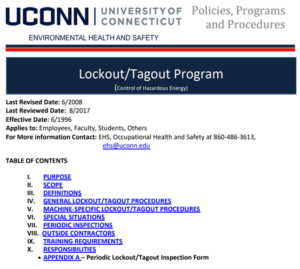What is Lockout Tagout?
Everything you ever needed to know about lockout tagout
What is lockout tagout?
Lockout tagout (LOTO) is a standardized procedure for securely disconnecting pieces of equipment from their energy sources to keep employees safe during asset management activities.
Locking and tagging out equipment ensures it does not suddenly start or release hazardous energy during either pre-scheduled or unplanned maintenance activities.
- Lockout: Locking a piece of machinery to isolate it from all energy sources and release any stored energy ensures it does not power up during maintenance or repair.
- Tagout: Tagging a device out by attaching a special tag or label clearly communicates information related to the shutdown. Tags should include warnings as well as details on the LOTO procedure and the authorized person responsible for executing it.
A Brief History of LOTO Standards
The United States Occupational Safety and Health Administration (OSHA) began developing its standards for lockout tagout procedures in 1982. Title 29 Code of Federal Regulations (CFR) Part 1910.147 became the law of the land in 1989.
OSHA’s lockout tagout standards compel businesses in industries like manufacturing to:
- Develop, introduce, and maintain standard LOTO procedures
- Educate employees on LOTO procedures
- Audit LOTO procedures at least once a year
Why does OSHA enforce its lockout tagout regulations? To help keep employees safe and help employers avoid the direct and indirect costs of workplace incidents. OSHA reports that failure to adequately disconnect energy sources leads to around 10% of serious injuries on the job.
OSHA’s estimates suggest that adhering to LOTO procedures helps businesses avoid 250,000 incidents, 50,000 injuries, and 120 fatalities each year.
Do OSHA’s lockout tagout rules apply to me?
Do your employees operate machinery that could cause an injury if it released stored energy or started unexpectedly? If so, your business is most likely subject to OSHA’s LOTO regulations. You’ll need standard procedures to ensure employees are safe while servicing the machinery. Procedures should cover processes like installation, inspection, cleaning, and modification.
OSHA maintains alternative standards for the safe control of energy in specific workplaces like marine terminals and construction sites.
LOTO Programs vs. LOTO Procedures
Though you may hear the terms used interchangeably, LOTO programs and LOTO procedures are not one and the same.
LOTO procedure: lockout tagout procedures are the specific processes employees must follow before servicing an individual piece of equipment.
LOTO programs: lockout tagout programs cover the full scope of relevant machinery within your organization and ensure all necessary LOTO procedures are clearly documented, widely understood, closely followed, and regularly updated.
Simply put, your lockout tagout program is your way of introducing, enforcing, and refining different lockout tagout procedures over time and enforcing compliance. These programs are essential components of any organization’s broader preventive maintenance program.
LOTO Recommendations for Employees and Employers
OSHA and the National Institute for Occupational Health and Safety (NIOSH) offer tips for business leaders and their teams to successfully introduce and maintain LOTO programs and procedures.
According to their guidelines, employers must:
- Implement lockout tagout standards and conduct training before anyone performs service work on any machinery.
- Ensure that all employees understand when and why LOTO procedures are necessary and how to carry them out.
- Develop procedures tailored to each unique piece of equipment.
- Provide workers with the necessary hardware for isolating all energy sources.
- Label isolation devices like control valves and break panels clearly.
Though employers are ultimately responsible for introducing and enforcing LOTO standards, the workforce has an important role to play too. To keep themselves and their peers safe, all employees must:
- Complete all required training and take pains to follow prescribed regulations for hazardous energy control.
- Take care that only authorized individuals add or remove locks and tags from machinery.
- Always verify that equipment has been successfully de-energized before beginning service.
- Conduct a thorough inspection before removing locks and reactivating equipment.
- Keep co-workers clear of any hazardous areas while servicing de-energized equipment.
Examples of LOTO Programs
Let’s take a closer look at a few examples of comprehensive lockout tagout programs.
University of Connecticut
The first example comes from UCONN. As you can see, the school’s LOTO program is clearly documented and has evolved over time. You can check out the full program here.

UCONN LOTO program content table
The University of Colorado, Colorado Springs (UCCS)
UCCS maintains even more detailed LOTO documentation. Though you’ll need a program tailored to your unique business, this practical example can offer some inspiration. You’ll find the school’s complete lockout tagout program here.

UCCS LOTO program content table
A Typical LOTO Procedure
The exact shape of your organization’s LOTO procedures will depend on your industry and the specific types of equipment your employees come in contact with. What’s more, you’ll need unique procedures for each unique piece of machinery. In general, however, lockout tagout procedures adhere to this basic structure:
- Prepare for shutdown: This includes notifying all affected employees of the pending shutdown and ensuring they understand both why the machine is being serviced and how long it will be de-energized.
- Review LOTO procedure: Review the asset-specific procedure.
- Perform the shutdown: Execute the shutdown according to the instructions outlined in the LOTO procedure.
- Locate and disconnect energy sources: The authorized employee should disconnect the equipment from all potential energy sources.
- Place locks and tags on assets: Once the equipment is isolated from its energy sources, the authorized employee will attach the appropriate locks and tags.
- Eliminate stored energy: To avoid incidents, the authorized employee should take care to release or block any excess energy like condensed air or tension from compressed springs.
- Verify the lockout: Ensure that the equipment is locked correctly. An easy way for employees to do this is by attempting the typical start-up process.
- Perform scheduled service: Service the de-energized machinery according to company guidelines.
- Restore the equipment to service: Follow the appropriate procedure for restoring the equipment to its usual state.
Common Lockout Tagout Mistakes to Avoid
Successfully implementing LOTO programs and procedures can quite literally make the difference between life and death. OSHA’s case studies paint a grim picture of what can happen when even one small thing goes wrong during equipment repairs and maintenance. Even non-fatal injuries could prove deadly for businesses. Injuries related to hazardous energy exposure force employees to miss an average of 24 workdays for recuperation.
Employers and employees should avoid these all-too-common mistakes in order to promote a culture of safety and keep things running smoothly:
- Leaving instructions up to interpretation: Clear step-by-step instructions or checklists make for safe workplaces. When developing LOTO programs and procedures, employers should actively engage their teams to ensure understanding and promote compliance.
- Neglecting LOTO procedures because they’re inconvenient: Sometimes it will take longer to lock out and tag out a piece of equipment than to inspect or repair it. That doesn’t mean you or your employees can forgo the usual protocols. A procedure is only effective if employees follow it to the letter each and every time.
- Failing to fully isolate energy sources: Don’t stop at locking out the circuit breaker! Always make sure that authorized employees have locked out every possible source of energy before servicing equipment.
- Asking someone else to carry out LOTO procedures: Only the personnel authorized to execute a specific LOTO procedure should have access to the relevant hardware. If an employee asks someone else to execute a procedure for them, they are potentially putting that employee and other co-workers in the area at risk.
- Leaving keys in locks: Improperly locking out equipment leaves open the possibility that machinery will unexpectedly start. Always double-check that there is no way for anyone to unintentionally unlock or untag a de-energized machine.
- Settling for good enough: Lockout tagout programs are living documents. Employers and employees should always look out for opportunities to refine existing programs and promote a safer workplace. Though OSHA requires annual audits, improvement should constitute a year-round initiative.
Want to see Limble in action? Get started for free today!
Maintain a Safer and More Productive Workplace with CMMS
Enforcing safety standards is much harder when you’re relying on legacy methods and solutions. Transitioning to a computerized maintenance management system could help simplify the processes of building LOTO plans, educating employees, and ensuring accountability for properly following procedures.


